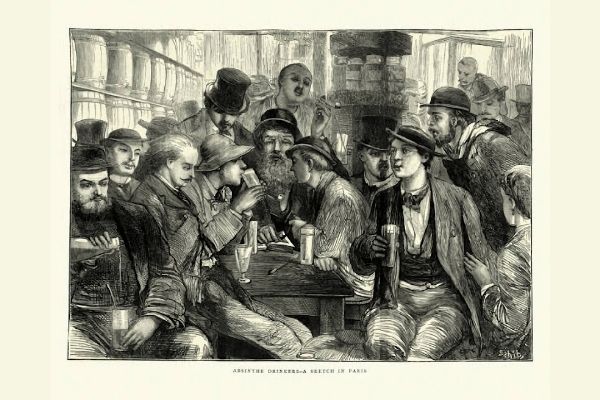
02/03/2022 This article covers everything about absinthe, one of the most contentious spirits in contemporary history.
Absinthe, also known as The Green Goddess, The Green Fairy, or The Green Lady, has long been a popular drink for artists and creative types. Absinthe influenced bohemian artists and writers such as Henri de Toulouse-Lautrec, Édouard Manet, Vincent van Gogh, Pablo Picasso, Ernest Hemingway, and Oscar Wilde. This divisive beverage was once a favorite of painters and writers due to its purported capacity to aid their creative flow.
Absinthe is a strong alcoholic spirit made by redistilling neutral alcohol with botanicals—the "holy trinity" being wormwood, anise, and fennel. Other frequent constituents include hyssop, melissa, star anise, and lemon balm. This intriguing drink, nicknamed la fée verte ("the green fairy") by nineteenth-century absinthe enthusiasts, derives its brilliant green color from the additional botanicals infused during the distillation process.

Composition of Absinthe
Wormwood oil, fennel, hyssop, and anise are the main ingredients in a bottle of absinthe. Wormwood (Artemisia absinthium) blossoms and leaves are the primary flavoring elements; other fragrant ingredients include licorice (which usually dominates the aroma), hyssop, fennel, angelica root, aniseed, and star aniseed. Because absinthe contains 45–74 percent alcohol, it is frequently diluted before ingestion, either with sweetened water or a cocktail. Absinthe tastes aniseed primarily, with fennel and licorice's crisp, flowery flavors. Wormwood is responsible for its natural bitterness. Absinthe imparts a spicy, herbal flavor to a variety of beverages.

Image source: Shuttershock, Absinthe cocktail
The Chrysanthemum, The Corpse Reviver, The Monkey Gland, The Morning Glory Fizz, and The Sazerac are the most famous absinthe cocktails. Using absinthe in a cocktail is a wonderful (and probably more approachable) way to become familiar with its properties.
Early forms of absinthe (drinkable wormwood) are mentioned in the Bible and ancient Egyptian and Syrian writings. Absinthe was a simpler formula back then, consisting of only wine laced with wormwood. It was used to treat various ailments such as jaundice, menstruation pain, anemia, and bad breath. Over the years, absinthe evolved from a medicinal to a recreational beverage, with the present absinthe formula first appearing in Swiss apothecaries in the late 1700s.
[[relatedPurchasesItems-31]]
Absinthe was supplied to French troops as a malaria preventative in the 1840s, which made them develop a taste for it when they returned home. As a result, it became widely popular among young urbanites. In addition, because of mass production procedures, absinthe's price fell, and it became one of the most popular alcoholic beverages in France.
However, the exceptionally high alcohol level of this drink was one of the reasons it was eventually outlawed in several countries by the early 1900s.

Image Source: iStock
Absinthe's history may be traced back to the late 18th century, when Pierre Ordinaire, a French doctor, employed wormwood (Artemisia absinthium) distilled with anise, fennel, hyssop, and other herbs as a herbal treatment for his patients. Ordinaire's recipe finally made its way into the hands of Henri-Louis Pernod, who founded the Pernod fils company. Henry-Louis Pernod utilized a recipe and created the beverage for the first time commercially in 1797. In 1908, Switzerland outlawed the production of absinthe, followed by France in 1915 and, subsequently, many other countries. In 1918, Pernod Fils opened a facility in Tarragona, Spain, to produce absinthe and a similar beverage without wormwood for export to nations that prohibited authentic absinthe. It is unknown whether absinthe has psychedelic properties. The psychological effects linked to the liquor were later supposedly caused by thujone, a poisonous substance found in wormwood; however, that theory was disapproved in the late 1990s. The production and sale was permitted in many nations, sparking a current revival in absinthe drinking.
Thujone is one of the active components in absinthe. Though it is appreciated for its digestive effects and menthol aroma, it can produce convulsions, loss of inhibition, and hallucinations in high dosages. Thujone can be harmful in extremely high amounts. It is a GABA (Gamma-aminobutyric acid) inhibitor, which blocks GABA receptors in the brain, producing convulsions if consumed sufficiently. It is naturally present in many foods but never in high enough concentrations to cause harm. There is also not enough thujone in absinthe to harm you. Thujone does not readily vaporize during distillation, and the majority of it remains in the still pot. Therefore, only absinthe prepared from a combination of grand wormwood essential oils and alcohol might have a dangerously high thujone content.

Image Source: Unsplash, Right method of serving Absinthe
The most typical way to consume absinthe is to dilute it with chilled water; Absinthe is traditionally bottled quite powerfully. While you can simply add icy water to absinthe, typically in a 3:1 to 5:1 water-to-absinthe ratio, there is a ritual, as with many beverages of the time. Absinthe fountains are water jugs on legs with a tap that let the water slowly trickle into your drink. Absinthe fountains were popularised in France.
The addition of sugar reduces the drink's excessive bitterness, while water dilutes its intensity to a more tolerable level. The absinthe cocktail is prepared by placing a sugar cube on a flat absinthe spoon (or a slotted spoon or a fork) and setting or holding the spoon over half an ounce to one ounce of absinthe in a short, stemmed cocktail glass. Next, pour three to five ounces of cold water over the sugar cube slowly, allowing the sugar to dissolve and infiltrate the absinthe drop by drop, producing the hazy white reaction known as "the louche."- This method is referred to as the "absinthe drip."
Since National Absinthe Day is around the corner, let's toast the drink known as "the green fairy." Celebrate the day by sipping absinthe in any conventional form or mixing it into one of your favorite cocktails. If you haven't tasted absinthe yet, here is the day.
Article By Aakriti Rawat, Beverage Trade Network
Header Image Source: Days of the year



